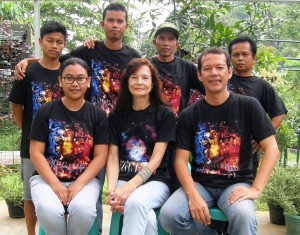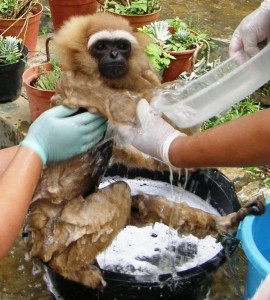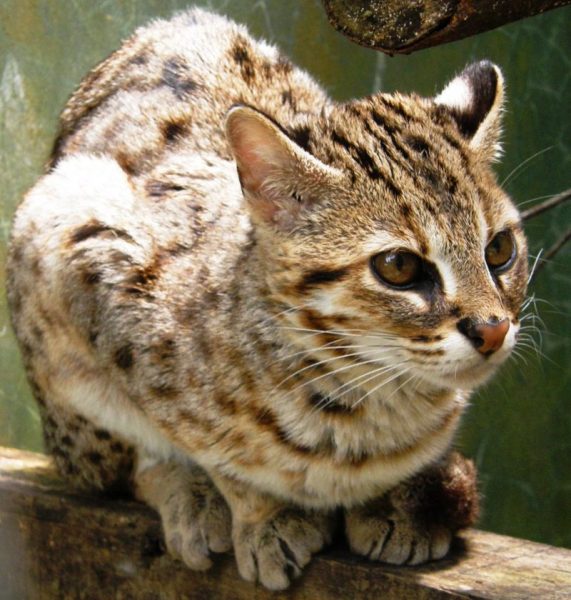Indonesia is blessed to be one of the most naturally biodiverse countries in the world; however this blessing comes with a curse: it is also one of the most densely populated, leading to tremendous impacts on wildlife habitat destruction and illegal wildlife trade. The animal trade in Indonesia is largely uncontrolled, due to weak enforcement, and has led to the highest number of threatened mammals and birds in the world.
According to statistics by wildlife trade monitoring network TRAFFIC, 1.5 million wild birds are caught and sold at pasar burung (bird markets) on the island of Java alone every year. Indonesia is considered one of the world’s top traders of non-timber forest products – a key supplier to external markets. Driving this trade is the end consumer, for instance tiger parts fuel a lucrative export trade to China, where their skins and bones are sold as souvenirs, talismans and ingredients for traditional medicines. People also purchase live animals as pets, drawn in by their attractiveness as infants, however once the animal reaches adulthood – especially with tigers – the owner is no longer able to look after the animal and looks to sanctuaries to take them off their hands.
The Natural Resources Conservation Agency (BKSDA) of the Ministry of Environment and Forestry works in collaboration with animal rescue NGOs to apprehend poachers and intercept trafficking rings, confiscating illegally-held animals. Inadequate resources and staff, however, often hamper control of poaching from protected areas, and the small number of rescue centres complicates the rescue of illegally-held animals across the country.
Annette Pipe is Co-Founder of Animal Sanctuary Trust Indonesia (ASTI) and entered into a life of rescuing and rehabilitating wildlife in 2008, along with Co-Founder Andy Kindangen. “We felt we needed to take some action to assist with the conservation of Indonesia’s animal biodiversity, and could no longer stand by and watch species disappearing without trying to do something about it,” Annette says.
ASTI rehabilitates displaced endangered species and assists in their conservation by eventually releasing them back to their natural habitats. Acting as a transit centre, ASTI is able to rescue and look after around 70 animals at any given time. On average, the sanctuary takes in 30-40 animals per year, and attempts to release or relocate the same number to make way for more animals in need. Rehabilitation rate and success depends on the species in question and on the condition of the animal on arrival at ASTI.
Since beginning operations, the centre has had many incredible cases of rescue, recovery and release. One in particular is that of a Javan leopard rescued six years ago from a deer snare in Banten province. “The leopard, named Aceng, was rescued in collaboration with the government and other NGOs,” Annette says. “Aceng quickly recovered from his wounds, and after ten months he left ASTI for release back to his forest in Pandeglang, Banten. ASTI still receives updates from the local people in Pandeglang that Aceng is alive and well – they recognise him from the scar around his abdomen.”
Sadly not all animals can be rehabilitated – some are too badly injured by poachers and would not survive life in the wild. In these circumstances, ASTI provides long-term care so that these animals can live healthy and happy lives in captivity. Currently the sanctuary has a few non-releasable animals, including an owl and an eagle – both with wing bones cut by the poachers – a cockatoo with no feathers, and a gibbon with liver problems.
Although extremely rewarding, working in wildlife rehabilitation is not without its challenges.
A recurring issue is that rescued animals have been eating food meant for humans, like fried rice or noodles, and must learn to eat their natural diet upon arriving at ASTI.
Animals often pick up viruses or bacteria at animal markets, some of which can be serious and difficult to treat. Oftentimes poachers and traders have mutilated the animals, for instance wing bones of eagles and owls are clipped, or teeth of slow lorises are cut or removed. Animals can also be traumatised from being held for years in small, dirty cages; in this case ASTI pays attention to their mental as well physical conditions. ASTI also faces the difficulty of finding suitable centres in other parts of Indonesia to accept their animals when they are ready for final rehabilitation and release.
Recently ASTI completed the rehabilitation of a leopard cat named Margo. Wild cats live in forested areas of Java, Sumatra and Kalimantan and unfortunately many people like to keep them as pets. Margo was handed over in January from a private home and luckily was healthy – her blood tests revealed that she was free from viruses often plaguing leopard cats who have been crammed together in animal markets – and was still quite wild, enabling her to respond well to the rehabilitation program. Margo is now ready to be released into a conservation area not far from ASTI.
The amazing work ASTI do is funded through kind donations. Donors can even sponsor a particular animal for a period of time, helping to cover the cost of food, shelter and medical expenses. Besides donating or sponsoring animals, Annette encourages people to make a difference by not buying protected animals from animal markets, and not visiting such markets at all, as animals in these markets are taken directly from the wild.
“While it is tempting to buy, for example, a baby monkey from a market in an effort to save that one individual, and to keep him as a pet, it is important to remember that for the traders to get the baby they almost certainly had to kill the mother,” Annette explains. “If you buy that baby, the poachers will replace him with another one, and another mother will be killed. The baby will most likely die anyway, from trauma at losing his mother and because survival rate without the mother is extremely low.”
Sometimes well-intentioned people buy these babies and other animals and bring them directly to ASTI, which Annette and Andy ask people do not do either, as the poachers will still go out and catch more from the wild. The cycle can only be broken by the consumer, Annette says. “We need to break the cycle; if nobody buys the animals, the poaching will stop.”
To find out how you can help ASTI please visit www.animalsanctuarytrustindonesia.org




